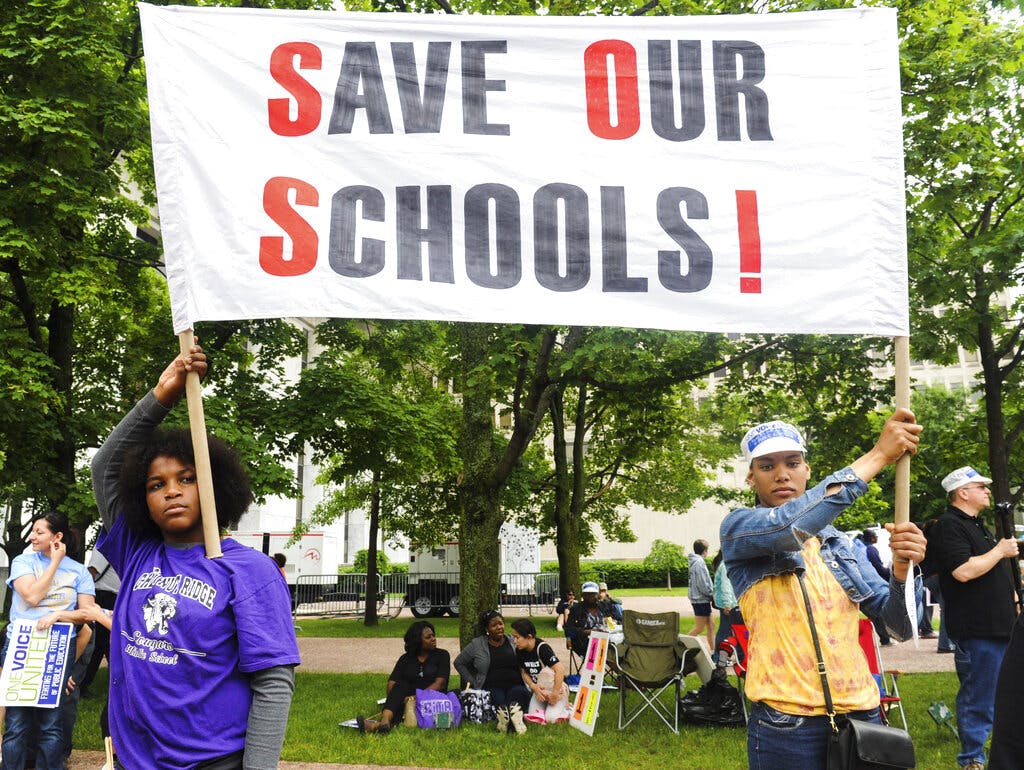Failed Public Schools at Rockland County Could Signal Broader Change
New Yorkers are leaving public schools, but unions are blocking budget cuts.

In many ways, the small East Ramapo, New York, public school district — now facing a “fiscal cliff” budget deficit of $40 million it must close by June 30 — seems unique. Some three-quarters of school-age children in the upstate Rockland County district attend private religious schools, mainly Orthodox Jewish yeshivas.
The remainder, mainly low-income Black and Latino children, attend a failing taxpayer-funded system. That system is in deep budget trouble — in no small part because local voters, most of whose children are in the private religious schools, repeatedly refuse to approve school budget increases.
This budget standoff might be unusual, but, as confidence declines in public schools across the country and a student exodus grows, this instance of “defunding the schools” could easily become more common. It suggests the need for school vouchers or a related “school choice” approach to become even more widespread.
The East Ramapo basics: Of 33,000 school-age children, 24,000 attend one of 52 yeshivas; only 10,000 — 91 percent of whom are Black or Latino — attend the property tax-funded public system. Their graduation rate is the lowest in Rockland County.
A state monitor has found that 84 percent of students between grade three and grade eight are not proficient in English language arts, while 87 percent do just as poorly in math. The majority of those are classed as “well below proficient.”
Proposals to lift a property tax cap to increase school funding for the troubled system fail regularly: six of 11 proposals have been voted down since 2012 and the district has seen a budget freeze in four of the past five years, according to Gannett’s Journal-News.
It is tempting to be cynical about the situation. Seven of nine school board members come from “the private school community.” They can be seen as starving a system because it doesn’t serve their children in what a 2014 state report describes as a “unique public/private school demographic.”
It has been a recipe for a bitter and racialized controversy, one that has prompted the local NAACP to contend the school board has shown indifference to the needs of minority students. The New York Civil Liberties Union, in a 2021 report titled “Private Privilege Public Ruin,” characterizes East Ramapo as “21st Century Jim Crow Education.”
Debate is fervid. At a school board meeting earlier this month, a local community activist, Luis Nivelo, dumped what he said was rotten elementary school cafeteria food on the dais, in front of a board member, Simon Koth. The day after, the police ordered public protection for the board member from the activist.
The school board’s spending of public funds to support universal busing in the district includes school transportation for the yeshiva students.
The school board can well be viewed as self-interested. But the East Ramapo district might also be seen as the exception that proves a rule — that property tax-funded, publicly-operated schools should be the American norm.
The East Ramapo chasidic and Orthodox parents represent just one of many groups of parents who have decided traditional public schools are not the best way to educate their children. They have voted with their feet to leave — and not to pay for what they don’t prefer to use.
Some 9.5 percent of students (approximately 100,000) have left the New York City public school system, the nation’s largest, yet teachers’ unions resist any budget reductions. The system’s charter school population — for which public funding is directed away from unionized schools — has ballooned to a similar number.
Nationwide, according to American Enterprise Institute’s Return to Learn Tracker, some 1.27 million students have left the public schools nationwide since the start of the pandemic. New York is among loss leaders.
As Chalkbeat reports, “New York City’s declines are striking and likely have led to the state’s dubious distinction: With 6 percent fewer students in schools statewide since the pandemic began, New York has seen the biggest declines of any state.”
In other words, rather than being viewed as an outlier, East Ramapo may be the leading edge, as parents vote with their feet against traditional public schools — as they fail to deliver results and unionized teachers regularly demand pay increases anyway.
There was a good deal to be said for traditional, municipally based taxpayer-funded schools. They can serve as the focus of community effort and pride — as school sports have always done. Some, especially in affluent suburbs, still play this role.
Yet when taxpayer-funded schools fail to perform, even as costs increase, taxpayers across the country can be expected to follow East Ramapo’s “defund” model. The governor of Arizona, Douglas Ducey, has signed legislation that provides $6,000 a year in education funds for that state’s one million students — to be used for everything from private school tuition to school supplies.
Here lies a common sense approach to helping the beleaguered public school students of East Ramapo: funds that would allow them to go elsewhere. High-performing charter school operators such as Success Academy could seek to open branches at East Ramapo.
Defunding public schools may be on the horizon, but it doesn’t mean defunding education. Parents in failing districts deserve the means to help their kids not just attend school but to learn.
___________________
Correction: Charter school operators are eligible to open branches at East Ramapo. An earlier version misstated their eligibility to do so.

